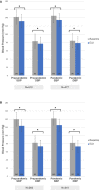Remote Cardiovascular Hypertension Program Enhanced Blood Pressure Control During the COVID-19 Pandemic
- PMID: 36915035
- PMCID: PMC10111523
- DOI: 10.1161/JAHA.122.027296
Remote Cardiovascular Hypertension Program Enhanced Blood Pressure Control During the COVID-19 Pandemic
Abstract
Background The COVID-19 pandemic disrupted traditional health care; one fallout was a drastic decrease in blood pressure (BP) assessment. We analyzed the pandemic's impact on our existing remote hypertension management program's effectiveness and adaptability. Methods and Results This retrospective observational analysis evaluated BP control in an entirely remote management program before and during the pandemic. A team of pharmacists, nurse practitioners, physicians, and nonlicensed navigators used an evidence-based clinical algorithm to optimize hypertensive treatment. The algorithm was adapted during the pandemic to simplify BP control. Overall, 1256 patients (605 enrolled in the 6 months before the pandemic shutdown in March 2020 and 651 in the 6 months after) were a median age of 63 years old, 57% female, and 38.2% non-White. Among enrolled patients with sustained hypertension, 51.1% reached BP goals. Within this group, rates of achieving goal BP improved to 94.6% during the pandemic from 75.8% prepandemic (P<0.0001). Mean baseline home BP was 141.7/81.9 mm Hg during the pandemic and 139.8/82.2 prepandemic, and fell ≈16/9 mm Hg in both periods (P<0.0001). Maintenance during the pandemic was achieved earlier (median 11.8 versus 19.6 weeks, P<0.0001), with more frequent monthly calls (8.2 versus 3.1, P<0.0001) and more monthly home BP recordings per patient (32.4 versus 18.9, P<0.0001), compared with the prepandemic period. Conclusions A remote clinical management program was successfully adapted and delivered significant improvements in BP control and increased home BP monitoring despite a nationally observed disruption of traditional hypertension care. Such programs have the potential to transform hypertension management and care delivery.
Keywords: COVID‐19; blood pressure; hypertension; remote patient monitoring; telehealth; telemedicine.
Figures



References
-
- Zhou B, Carrillo‐Larco RM, Danaei G, Riley LM, Paciorek CJ, Stevens GA, Gregg EW, Bennett JE, Solomon B, Singleton RK, et al. Worldwide trends in hypertension prevalence and progress in treatment and control from 1990 to 2019: a pooled analysis of 1201 population‐representative studies with 104 million participants. Lancet. 2021;398:957–980. doi: 10.1016/S0140-6736(21)01330-1 - DOI - PMC - PubMed
Publication types
MeSH terms
Grants and funding
LinkOut - more resources
Full Text Sources
Medical

